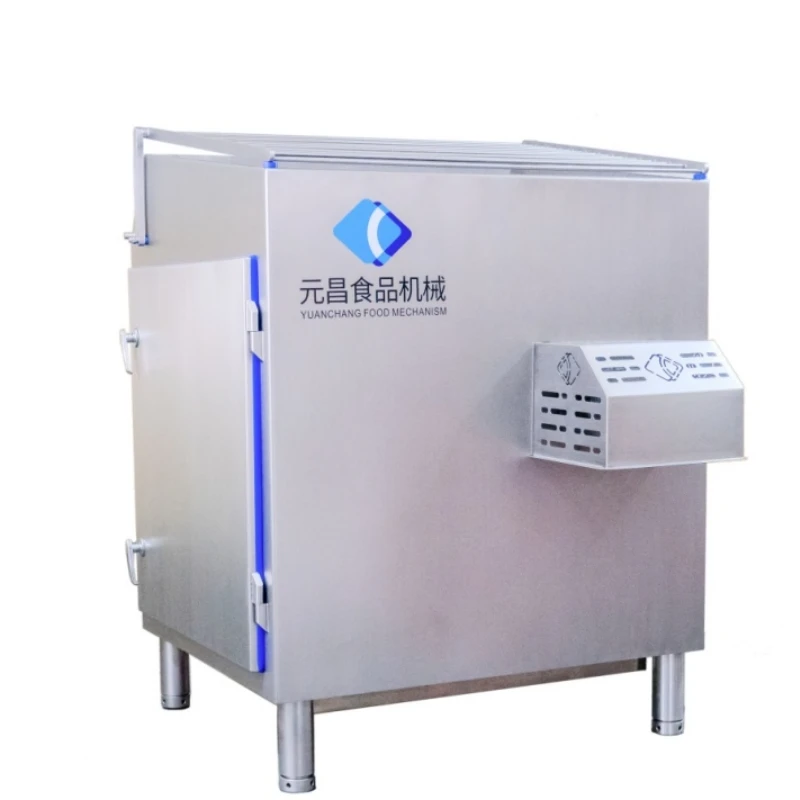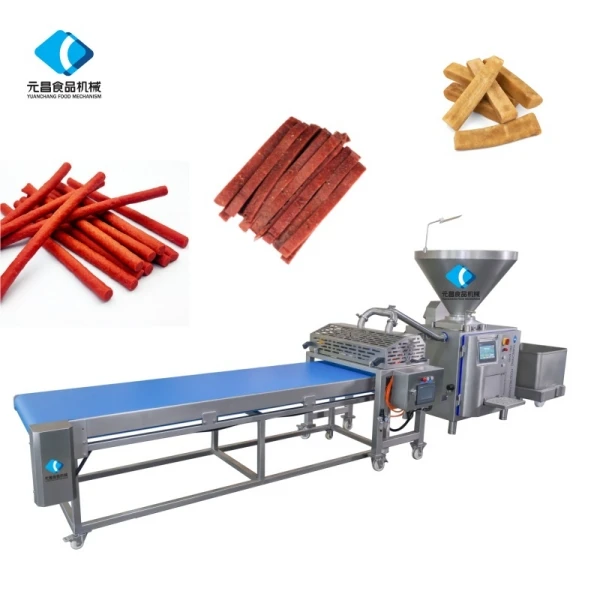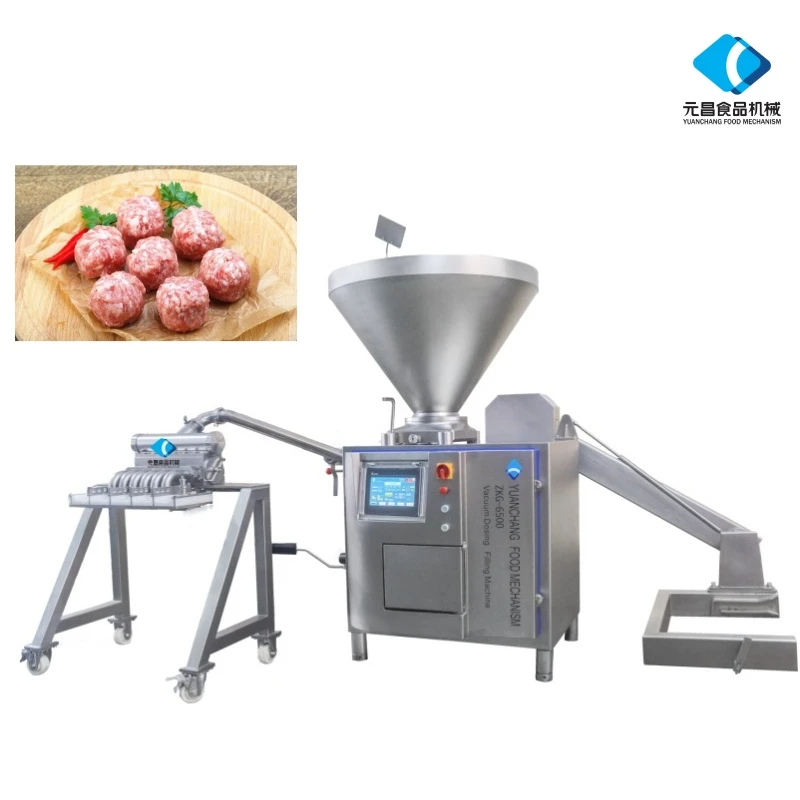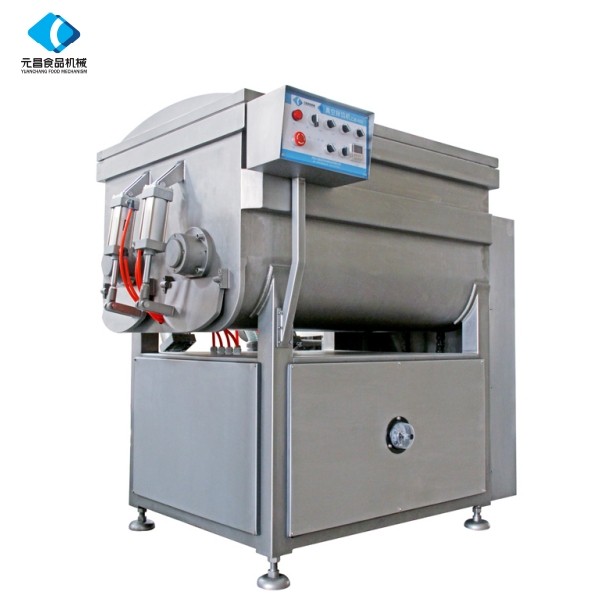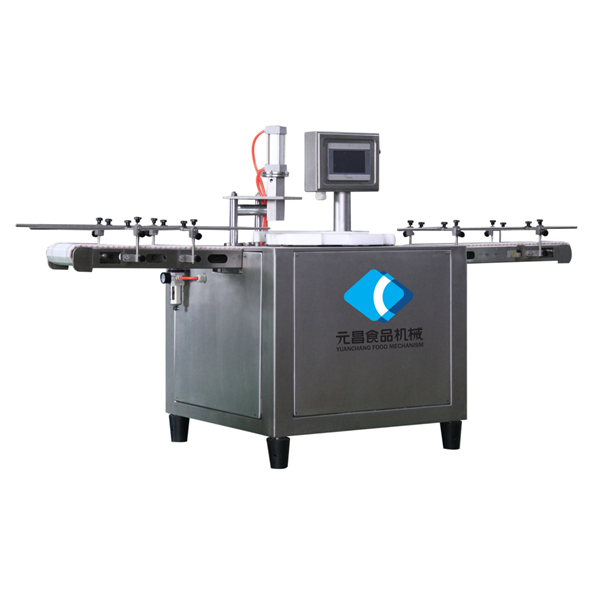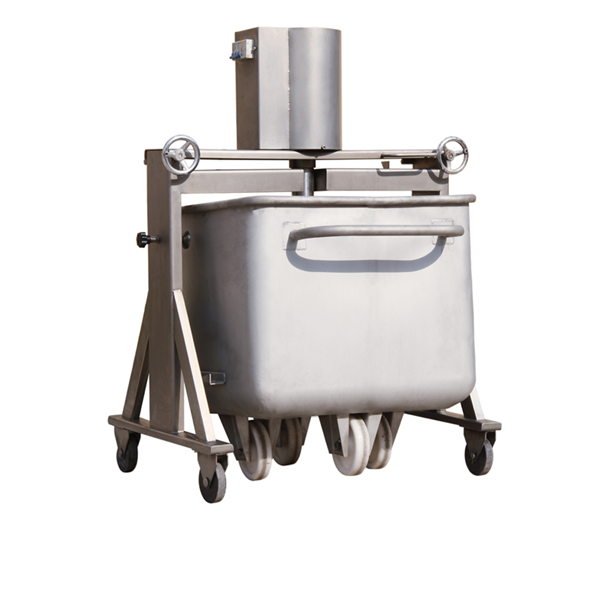High-Precision Sausage Cutting Machine | Efficient Slicing
Navigating the Precision World of Sausage Cutting Machines in Modern Food Processing
In the dynamic and rapidly evolving landscape of the food processing industry, efficiency, hygiene, and precision are paramount. At the heart of high-volume sausage production lies a critical piece of equipment: the sausage cutting machine. This sophisticated device is not merely a cutter; it is an indispensable tool that ensures consistent product quality, optimizes throughput, and significantly contributes to operational profitability. As consumer demand for diverse and high-quality sausage products continues to surge globally, the technological advancements in sausage machines have become a cornerstone for manufacturers striving for excellence and competitiveness. This comprehensive article delves into the intricate world of these machines, exploring their technological underpinnings, application versatility, and the crucial factors that define their value proposition in today's market.
The journey from raw ingredients to packaged sausage food involves multiple precise steps, and the cutting or portioning phase is where consistency is truly sealed. Whether dealing with fresh sausages, smoked varieties, or dried delicacies, the ability to cut with extreme accuracy impacts not only the aesthetic appeal but also the cooking consistency and overall consumer experience. Understanding the nuances of a sausage cutting machine, from its robust construction to its intelligent control systems, is vital for any B2B stakeholder looking to invest in long-term operational excellence and sustainable growth.
Industry Trends and Market Dynamics Shaping Sausage Machine Technology
The global market for sausage machines is experiencing significant growth, driven by several key trends:
- Automation and Robotics Integration: There is a clear shift towards fully automated production lines to reduce labor costs, enhance hygiene, and minimize human error. Advanced sausage cutting machine models now feature sophisticated robotic arms for handling and precise cutting, improving throughput by up to 30% in high-volume facilities.
- Emphasis on Food Safety and Hygiene: Stringent global food safety regulations (e.g., HACCP, FDA, CE) demand machines that are easy to clean, made from food-grade materials (primarily stainless steel 304 and 316L), and designed to prevent cross-contamination. Innovations in Clean-In-Place (CIP) systems are becoming standard.
- Versatility and Customization: Producers require machines capable of handling a wide array of sausage types, sizes, and casing materials. Modern sausage cutting machine technology offers quick changeover capabilities and adjustable parameters to accommodate diverse product specifications, meeting the evolving demands of the sausage food market.
- Sustainability and Energy Efficiency: Energy consumption and waste reduction are growing concerns. Manufacturers are developing more energy-efficient motors and optimized cutting processes that reduce product waste, leading to a notable reduction in operational costs.
- Data Analytics and IoT: Integration of Internet of Things (IoT) sensors allows for real-time monitoring of machine performance, predictive maintenance, and data-driven optimization of the cutting process, enhancing overall equipment effectiveness (OEE).
These trends underscore the importance of investing in cutting-edge technology that offers not just efficiency but also adaptability and adherence to the highest safety standards. The latest generation of sausage cutting machine embodies these advancements, offering solutions that are robust, intelligent, and designed for the future of food processing.
Understanding the Sausage Cutting Machine: Core Principles and Technical Specifications
A sausage cutting machine is engineered to precisely portion continuous strands of sausages into predetermined lengths, whether linked or unlinked. The core principle revolves around a synchronized feed mechanism and a high-precision cutting blade system. Depending on the model, this can range from rotary blades to ultrasonic cutters, each designed for specific applications and levels of delicacy.
Key Components and Their Functions:
- Feeding System: Often a conveyor belt or roller system, ensuring a consistent and gentle feed of sausages to the cutting station. Precision feed mechanisms, sometimes servo-driven, are crucial for accurate portioning.
- Cutting Unit: The heart of the machine. This can be a rotating knife system, a guillotine-style blade, or, for extremely delicate products, an ultrasonic cutting head. Blades are typically made of high-grade stainless steel (e.g., 440C) for durability and sharpness.
- Control System (PLC/HMI): A programmable logic controller (PLC) manages all machine functions, ensuring synchronization between feeding and cutting. A Human-Machine Interface (HMI) provides an intuitive touchscreen for operators to set parameters, monitor performance, and diagnose issues.
- Safety Features: Interlocks, emergency stops, and protective covers are standard to ensure operator safety during operation and maintenance.
- Hygienic Design: Components in contact with sausage food are made of polished stainless steel, with smooth surfaces and minimal crevices to prevent bacterial growth and facilitate easy cleaning.
To illustrate the capabilities, here is a general table of typical technical parameters for a high-performance sausage cutting machine:
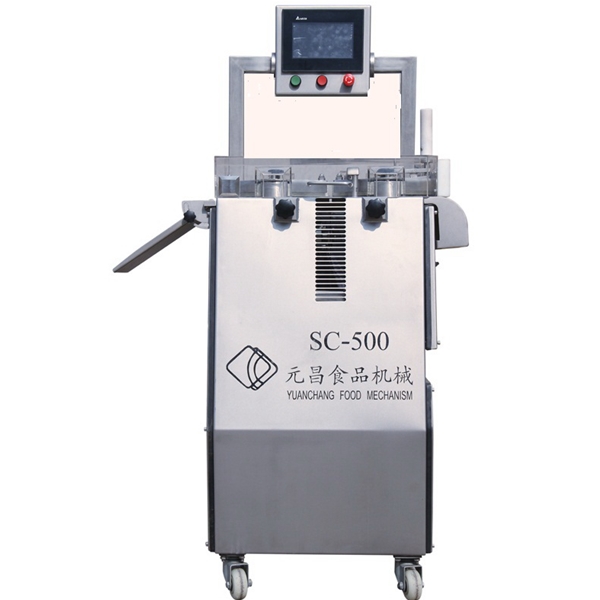
| Parameter | Typical Range / Value | Remarks |
|---|---|---|
| Production Capacity | Up to 600 cuts/min (variable) | Depends on sausage length & diameter |
| Sausage Diameter Range | 10 mm - 60 mm (adjustable) | Special configurations for larger sizes |
| Cutting Length Accuracy | ±1.0 mm or better | Critical for portion control and consistency |
| Motor Power | 1.5 kW - 5.0 kW | Servo motors for high precision and efficiency |
| Material Construction | Food-grade Stainless Steel (SUS304/316L) | Corrosion resistance, hygiene standards |
| Control System | PLC with HMI Touchscreen | User-friendly operation, diagnostics |
| Power Supply | 3-Phase, 380V/50Hz (customizable) | Adapted to regional power grids |
| Noise Level | ≤ 70 dB(A) | Ensures a comfortable working environment |
The Manufacturing Process of a High-Precision Sausage Cutting Machine
The creation of a robust and hygienic sausage cutting machine involves a meticulous manufacturing process, ensuring both performance and longevity. At YC Meat Mech, we adhere to the highest engineering standards, integrating advanced techniques from material selection to final assembly and rigorous testing.
1. Material Selection:
The primary material used is premium food-grade stainless steel, typically SUS304 or SUS316L. SUS304 offers excellent corrosion resistance and hygiene, while SUS316L provides superior resistance to chlorides and other harsh processing environments, often used for critical components. These materials are chosen for their non-reactive properties, durability, and ease of sanitation, complying with FDA and European food contact material regulations. Blades are crafted from high-carbon stainless steels like 440C, known for their hardness and edge retention.
2. Precision Manufacturing Processes:
- CNC Machining: Core components, such as gear housings, blade mounts, and precision shafts, undergo Computer Numerical Control (CNC) machining. This ensures extremely tight tolerances, high precision, and repeatability, crucial for the cutting accuracy of the sausage cutting machine.
- Laser Cutting and Forming: Stainless steel sheets for the machine frame and enclosures are precisely cut using laser technology, followed by hydraulic bending and forming to create robust, seamlessly fitting parts.
- Welding: Argon arc welding or TIG welding is employed for joining stainless steel components. This technique creates strong, clean welds with minimal distortion, and welds are then ground and polished to achieve a smooth, hygienic finish, preventing potential harborage points for bacteria.
- Surface Treatment and Polishing: All surfaces in contact with sausage food or requiring easy cleaning are highly polished (e.g., to a Ra 0.8 µm finish). This electropolishing or mechanical polishing reduces surface roughness, enhancing hygiene and corrosion resistance, and significantly extending the lifespan of the machine.
3. Quality Control and Inspection Standards:
Each sausage cutting machine undergoes rigorous multi-stage quality control:
- Material Inspection: Raw materials are inspected upon arrival to ensure they meet specified chemical composition and mechanical properties.
- In-process Inspection: During each manufacturing stage (machining, welding, assembly), dimensions, finishes, and functional aspects are checked against engineering drawings.
- Final Assembly and Testing: Once assembled, every sausage cutting machine undergoes extensive functional testing, including:
- Cutting Accuracy Test: Verified using various sausage types and speeds.
- Operational Stability Test: Running for extended periods to ensure consistent performance.
- Noise and Vibration Test: Ensuring compliance with workplace safety and comfort standards.
- Electrical Safety Test: Adherence to international standards like CE.
- Hygiene Conformity: Visual inspection of all contact surfaces and ease of cleaning.
- Certification Compliance: Our manufacturing processes and products are designed to meet international standards such as ISO 9001 (Quality Management), CE (European Conformity), and are built with materials conforming to FDA (Food and Drug Administration) requirements for food contact machinery.
4. Service Life and Durability:
Due to the robust material selection and precision engineering, a well-maintained sausage cutting machine from YC Meat Mech typically boasts a service life of 10-15 years, often longer with proper preventative maintenance and timely part replacement. Our machines are built to withstand the demanding environment of food processing plants, exhibiting high resistance to corrosion, wear, and fatigue. This extends the product's useful life, reducing total cost of ownership (TCO) for our clients.
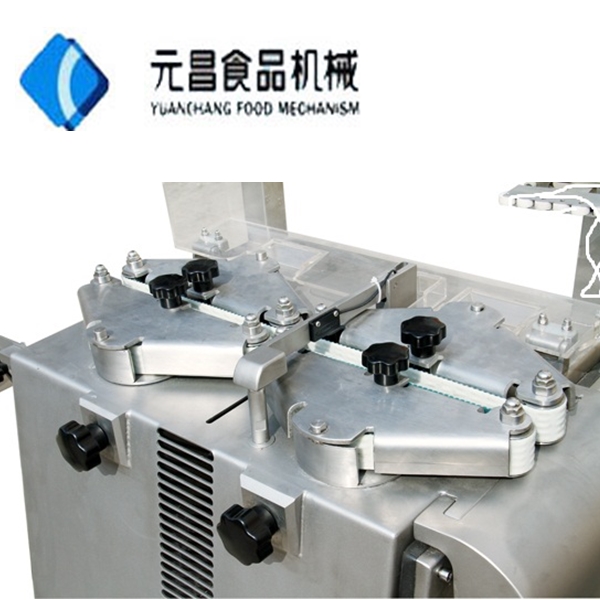
Application Scenarios and Industry Benefits
The versatility of a modern sausage cutting machine makes it indispensable across various segments of the sausage food industry. Its applications span from small-scale artisanal producers to large-scale industrial plants, each benefiting from its precision and efficiency.
Typical Application Areas:
- Fresh Sausage Production Lines: For uniform portioning of fresh breakfast sausages, Italian sausages, and bratwursts. The precise cuts ensure consistent cooking times and consumer satisfaction.
- Smoked and Cooked Sausage Processing: Handling cooked or smoked sausages like frankfurters, bologna, or kielbasa, requiring gentle yet firm cutting to maintain integrity.
- Dry Sausage and Salami Production: Specialized sausage slicer machine functionalities can be integrated to cut dried sausages without crumbling or damaging the delicate casing.
- Pet Food Industry: Certain models are adapted for cutting pet food sausages, adhering to similar hygiene and precision standards.
- Integration with Other Sausage Machines: A sausage cutting machine seamlessly integrates into broader production lines, following processes like stuffing (from sausage fillers) and preceding packaging or further processing. It often works in tandem with a sausage clipper machine, which seals and portions sausages before they enter the cutting unit.
Core Advantages in Typical Application Scenarios:
- Enhanced Productivity: Automated cutting significantly increases output compared to manual methods, enabling factories to meet high market demands efficiently. A typical sausage cutting machine can process hundreds of pieces per minute, a feat impossible manually.
- Superior Product Uniformity: Consistent length and weight of each sausage piece are guaranteed, which is crucial for packaging, cooking consistency, and meeting regulatory standards for portion size. This reduces give-away and optimizes yield.
- Improved Hygiene and Food Safety: Designed with smooth, accessible stainless steel surfaces and often featuring automated cleaning cycles (CIP), these machines minimize human contact and reduce the risk of contamination, aligning with ISO 22000 and HACCP principles.
- Reduced Labor Costs: Automation drastically cuts down the need for manual labor in the cutting phase, freeing up personnel for other tasks and reducing operational expenses.
- Minimized Product Waste: Precise cutting technology ensures minimal trim waste, maximizing the yield from each sausage strand and contributing to cost savings and environmental sustainability.
- Energy Efficiency: Modern sausage machines, especially those with servo-driven motors, are designed for optimal energy consumption, contributing to lower utility bills and a reduced carbon footprint for the processing plant. For example, some models consume up to 15% less energy than older hydraulic counterparts.
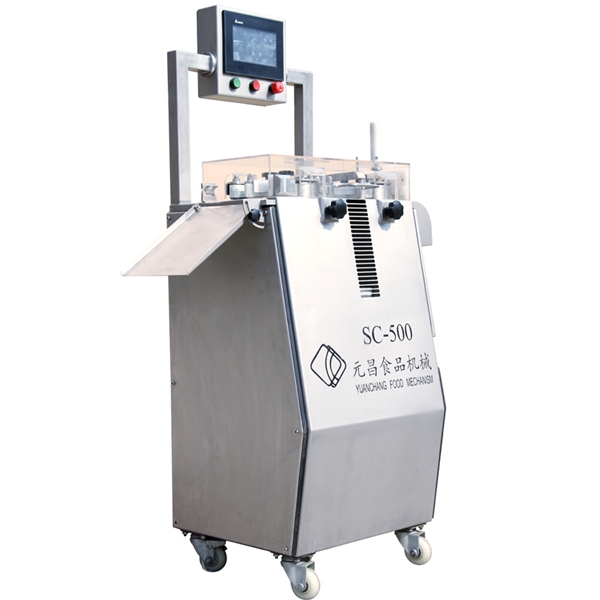
Technical Advantages and Innovation in Sausage Cutting Technology
The evolution of the sausage cutting machine is marked by continuous innovation, focusing on precision, automation, and adaptability. YC Meat Mech integrates several cutting-edge technologies to deliver superior performance.
1. Advanced Blade Technology and Cutting Mechanisms:
- Rotary and Guillotine Blades: High-speed rotary blades are ideal for precise, rapid cutting of linked sausages. Guillotine-style blades offer clean cuts for unlinked or larger diameter products. Both are crafted from specialized stainless steels to ensure long-lasting sharpness.
- Ultrasonic Cutting: For delicate or sticky sausage food products, ultrasonic cutting technology employs high-frequency vibrations to slice through material with minimal friction and no deformation, producing exceptionally clean cuts without tearing or smearing. This is particularly effective for cooked or highly viscous sausages.
- Self-Sharpening Systems: Some advanced models incorporate automatic or semi-automatic blade sharpening mechanisms, maintaining optimal cutting performance and reducing downtime for maintenance.
2. Precision Automation and PLC Control:
- Servo Motor Technology: Precision servo motors drive the feeding and cutting mechanisms, allowing for unparalleled control over speed, acceleration, and position. This results in highly accurate cutting lengths (e.g., ±0.5mm precision achievable) and minimal product deviation, even at high speeds.
- Integrated PLC Systems: Our sausage cutting machine systems are controlled by industrial-grade PLCs, enabling seamless integration with upstream (e.g., stuffing, clipping) and downstream (e.g., packaging) equipment. This creates a fully synchronized production line.
- Intuitive HMI Touchscreens: User-friendly Human-Machine Interfaces with graphical displays allow operators to easily adjust cutting parameters, store recipes for different products, monitor performance metrics (e.g., cuts per minute, total output), and access diagnostic information.
3. Hygienic Design and Ease of Cleaning:
- Open Frame Design: Minimizes horizontal surfaces and features sloped design elements to prevent liquid accumulation and facilitate drainage during cleaning.
- Quick-Release Components: Parts that require frequent cleaning, such as conveyor belts and blade assemblies, are designed for tool-less removal and reinstallation, significantly reducing cleaning time and effort.
- IP-Rated Enclosures: Electrical components are housed in highly sealed (e.g., IP65 or IP67) enclosures, protecting them from water ingress during washdown procedures and ensuring long-term reliability in wet environments.
4. Safety and Reliability:
- Comprehensive Safety Interlocks: Gates and covers are equipped with safety interlocks that immediately stop machine operation if opened, preventing access to moving parts during operation.
- Emergency Stop Buttons: Strategically placed emergency stop buttons provide immediate shutdown capability in critical situations.
- Robust Construction: Heavy-duty stainless steel frames and components ensure structural integrity and stability, even under continuous high-speed operation, contributing to a longer lifespan and reduced maintenance needs.
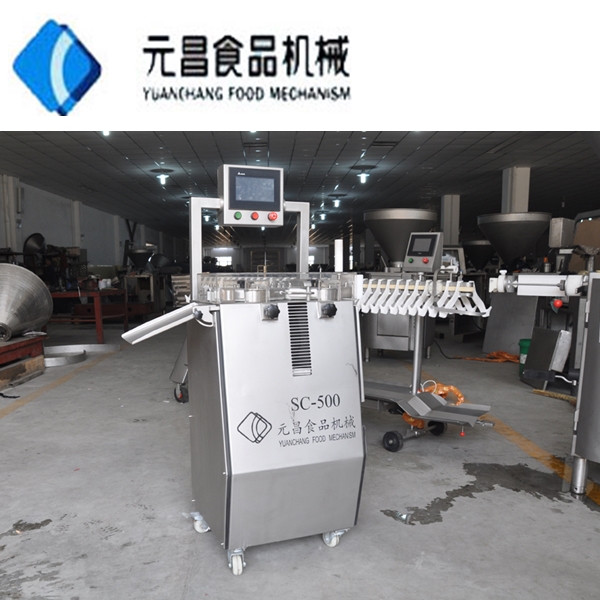
Manufacturer Comparison and Selection Criteria
Choosing the right sausage cutting machine manufacturer is a critical decision that impacts long-term operational efficiency and profitability. While numerous manufacturers exist, differentiating factors in technology, service, and support can significantly vary.
Key Factors to Consider When Selecting a Supplier:
- Technological Sophistication: Does the machine incorporate servo drives, advanced PLC controls, and hygienic designs? Is there an option for ultrasonic cutting for delicate products?
- Customization Capabilities: Can the manufacturer adapt the sausage cutting machine to specific product dimensions, line speeds, or integration requirements?
- Quality of Materials and Workmanship: Verify the use of food-grade stainless steel (SUS304/316L) and high-quality components from reputable brands (e.g., Siemens, Schneider, Rockwell for controls).
- Certifications and Compliance: Ensure the machines meet relevant international food safety and electrical standards (e.g., CE, UL, NSF, HACCP, ISO 9001).
- After-Sales Support and Spare Parts Availability: A reliable supplier offers comprehensive technical support, readily available spare parts, and responsive service to minimize downtime.
- Industry Reputation and Experience: Look for manufacturers with a proven track record, extensive service years in the food processing industry, and positive customer feedback.
- Total Cost of Ownership (TCO): Beyond the initial purchase price, consider energy efficiency, maintenance costs, expected lifespan, and the cost of spare parts.
Manufacturer Comparison Table (Illustrative):
While direct comparisons require specific model data, this table provides a general framework of what to evaluate:
| Feature/Aspect | YC Meat Mech | Competitor A (Premium) | Competitor B (Value) |
|---|---|---|---|
| Build Material Quality | High-grade SUS304/316L | High-grade SUS304/316L | Standard SUS304 |
| Automation Level | Advanced PLC, Servo-driven | Advanced PLC, Servo-driven | Basic PLC, Stepper motors |
| Cutting Precision | Exceptional (±0.5mm) | Exceptional (±0.5mm) | Good (±2.0mm) |
| Hygiene Design | CIP-ready, Open frame, Polished | CIP-ready, Open frame, Polished | Standard, easy-to-clean |
| Customization | Highly flexible, modular | Flexible, some modularity | Limited |
| After-Sales Support | Global, responsive, parts stock | Global, high-cost parts | Local/Regional, basic |
| Pricing | Competitive (High-Value) | Premium | Economical |
YC Meat Mech positions itself as a provider of high-value, technologically advanced sausage cutting machine solutions that rival premium brands in performance and quality, while maintaining a competitive price point and superior customer support. Our focus on precision engineering, robust construction, and adaptable design ensures that our machines are not just purchases but long-term investments for our clients.
Customized Solutions and Tailored Engineering
Recognizing that no two food processing operations are identical, YC Meat Mech specializes in offering customized sausage cutting machine solutions. Our engineering team works closely with clients to understand their specific product requirements, existing line configurations, and future growth projections.
Approach to Customization:
- Consultative Design Process: We engage in detailed discussions to determine optimal cutting technology (rotary, guillotine, ultrasonic), appropriate feeding systems, and desired production speeds.
- Material and Component Selection: Tailoring the choice of stainless steel (SUS304, SUS316L) or specific control components (Siemens, Allen-Bradley) based on environmental conditions, regulatory requirements, and client preferences.
- Integration with Existing Lines: Our engineers design machines that seamlessly integrate with your current sausage machines, including stuffers, clippers, and packaging lines, ensuring smooth workflow and maximum efficiency. This might involve custom conveyor heights, synchronization protocols, or footprint adjustments.
- Product-Specific Adaptations: Whether it's handling extra-long sausages, very small cocktail sausages, or unique casing materials, we can adjust blade designs, feed mechanisms, and control programming to ensure perfect cuts every time. For instance, a client producing very thin sausages may require a specialized guide and blade system to prevent tearing, which our custom solution can provide.
- Software and Recipe Management: Custom programming for the HMI allows for pre-setting and quick recall of numerous product recipes, reducing changeover times and minimizing operator error.
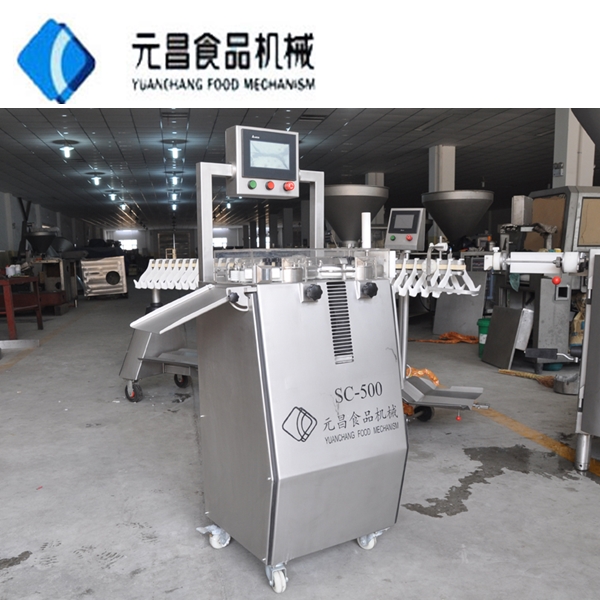
Real-World Application Cases and Customer Success Stories
Our expertise in sausage cutting machine technology is best demonstrated through the success of our clients. Below are illustrative examples of how YC Meat Mech solutions have empowered food processors:
Case Study 1: Large-Scale Frankfurther Production
- Challenge: A major meat processor needed to increase their frankfurter production capacity and achieve greater portioning accuracy to reduce giveaway. Their existing sausage cutting machine struggled with high speeds and consistent length.
- Solution: YC Meat Mech supplied a high-speed, servo-driven sausage cutting machine integrated with their existing clipper line. The machine featured an optimized rotary blade system and advanced tension control on the feeding mechanism.
- Result: Production output increased by 25%, and the consistency of frankfurter length improved by 98%, leading to a 3% reduction in product giveaway. The client reported a significant boost in operational efficiency and packaging consistency.
Case Study 2: Artisanal Specialty Sausage Manufacturer
- Challenge: An artisanal producer of various gourmet sausages needed a versatile sausage slicer machine that could handle different casing types (natural, collagen) and varying diameters without damaging the delicate product. Manual slicing was slow and inconsistent.
- Solution: We provided a modular sausage cutting machine with quick-change tooling for different sausage diameters and an optional ultrasonic cutting head for their most delicate products. The HMI was programmed with custom recipes for each product type.
- Result: The client achieved precise, clean cuts on all their specialty products, dramatically improving presentation and reducing product damage by 15%. They were able to diversify their product line and increase production without compromising quality.
Case Study 3: Pet Food Sausage Manufacturer
- Challenge: A growing pet food company required a robust sausage cutting machine capable of processing dense, high-moisture pet food sausages at high speeds while maintaining strict hygiene.
- Solution: YC Meat Mech designed a specialized sausage cutting machine with reinforced components, enhanced IP-rated electrical systems for frequent washdowns, and a powerful, dedicated cutting unit designed for tougher textures.
- Result: The machine significantly boosted their throughput and portioning accuracy for pet food products, exceeding previous capabilities. The client praised the machine's durability and ease of cleaning, which met their stringent food safety standards for animal consumption.
Ensuring Trust: Quality Assurance, After-Sales Support, and Certifications
Trust is the bedrock of any successful B2B relationship. At YC Meat Mech, we build trust through unwavering commitment to quality, comprehensive support, and adherence to global standards for our sausage machines.
Certifications and Compliance:
Our sausage cutting machine products and manufacturing processes adhere to the highest international standards:
- ISO 9001: Our quality management system is certified to ISO 9001, ensuring consistent quality in design, development, production, installation, and service.
- CE Marking: All our equipment complies with the essential health and safety requirements set out in European directives, allowing for free movement within the European Economic Area.
- FDA Compliance: Materials in contact with food are selected and treated to meet the stringent requirements of the U.S. Food and Drug Administration, guaranteeing food safety and suitability for processing sausage food.
- HACCP Principles: Our machines are designed with HACCP (Hazard Analysis and Critical Control Points) principles in mind, facilitating easy sanitation and minimizing contamination risks, thereby supporting our clients' food safety programs.
Warranty and Quality Guarantee:
We stand by the quality of our sausage cutting machine. Each machine typically comes with a standard 12-month warranty from the date of commissioning or 18 months from delivery, whichever comes first. This covers manufacturing defects and component failures under normal operating conditions. Extended warranty options are also available.
After-Sales Support and Customer Service:
Our commitment extends far beyond the sale. We provide comprehensive after-sales support to ensure your sausage cutting machine operates optimally throughout its lifespan:
- Technical Support: Our team of experienced engineers provides prompt technical assistance via phone, email, and remote diagnostics to troubleshoot issues and offer expert advice.
- Spare Parts Availability: We maintain a comprehensive inventory of genuine spare parts, ensuring quick dispatch and minimizing downtime for repairs. Critical wear parts are readily available.
- On-site Service and Training: For complex issues or new installations, we offer on-site technical support, including installation supervision, commissioning, and operator training to ensure your team is proficient in operating and maintaining the equipment.
- Preventative Maintenance Programs: We offer tailored maintenance programs to help clients proactively maintain their machines, extending their lifespan and ensuring peak performance.
Delivery Cycle:
The typical delivery cycle for a standard sausage cutting machine is generally 8-12 weeks from order confirmation, depending on the specific model and current production schedule. Custom-engineered solutions may require a longer lead time, typically 12-16 weeks, to accommodate design, manufacturing, and rigorous testing phases. We work closely with our clients to establish realistic timelines and provide regular updates on order status.
Frequently Asked Questions (FAQ) about Sausage Cutting Machines
Q1: What types of sausages can a YC Meat Mech sausage cutting machine process?
A: Our machines are highly versatile and can process a wide range of sausage types, including fresh sausages (e.g., breakfast, Italian), cooked sausages (e.g., frankfurters, bologna), smoked sausages (e.g., kielbasa), dry sausages, and even certain pet food sausages. They can handle various casings such as natural, collagen, and cellulose, with adjustable settings for diameter and length.
Q2: How does the sausage cutting machine ensure hygiene?
A: Hygiene is paramount in our design. Our machines are constructed primarily from food-grade SUS304 or SUS316L stainless steel, featuring highly polished surfaces to prevent bacterial adhesion. They boast open-frame designs for easy access, quick-release components for thorough cleaning, and are often compatible with Clean-In-Place (CIP) systems. Electrical components are sealed with high IP ratings to withstand rigorous washdowns.
Q3: What is the typical lifespan of a sausage cutting machine from YC Meat Mech?
A: With proper maintenance and regular servicing, our sausage machines are designed for a long operational life, typically 10-15 years or more. Their robust construction and use of high-quality components ensure durability and consistent performance over time.
Q4: Can a sausage cutting machine be integrated into an existing production line?
A: Absolutely. Our machines are designed with modularity and flexibility in mind. Our engineering team can work with you to ensure seamless integration with your current sausage machines, such as stuffers and sausage clipper machine units, as well as downstream packaging equipment, optimizing your entire production flow.
Q5: What kind of after-sales support does YC Meat Mech provide?
A: We offer comprehensive after-sales support including remote technical assistance, readily available genuine spare parts, on-site installation and commissioning services, and operator training programs. Our goal is to ensure continuous, trouble-free operation of your sausage cutting machine.
Conclusion: The Future of Sausage Processing with Advanced Cutting Technology
The modern sausage cutting machine is more than just a piece of equipment; it is a strategic investment that drives efficiency, ensures product quality, and enhances food safety in the highly competitive food processing sector. From precision engineering and robust material selection to advanced automation and comprehensive after-sales support, every aspect of these machines is designed to meet the rigorous demands of B2B clients.
As consumer preferences continue to diversify and regulatory standards become even more stringent, the role of a technologically superior sausage cutting machine will only grow. Manufacturers like YC Meat Mech are at the forefront of this evolution, continuously innovating to deliver solutions that not only optimize current production but also lay the groundwork for future scalability and sustainable growth. By prioritizing precision, hygiene, and intelligent design, we empower food processors to achieve new levels of excellence in the production of high-quality sausage food products for global markets.
References
- Food and Drug Administration. "Current Good Manufacturing Practices, Hazard Analysis, and Risk-Based Preventive Controls for Human Food." Federal Register, 2015.
- International Organization for Standardization. "ISO 9001:2015 - Quality management systems - Requirements." 2015.
- European Committee for Standardization. "Machinery Directive 2006/42/EC." 2006.
- Meat & Poultry Magazine. "The State of Meat Processing Automation." Annual Industry Report, various years.
- Journal of Food Science and Technology. "Advances in Food Processing Technologies for Meat Products." Various issues.
-
Discover the Benefits of Vacuum Marinating Machines for Efficient Food ProcessingNewsNov.24,2025
-
The Ultimate Guide to Commercial Chicken Scalders: Efficiency, Sustainability & InnovationNewsNov.23,2025
-
Chicken Harvesting Equipment: Efficient & Humane Solutions for Poultry ProducersNewsNov.22,2025
-
Comprehensive Guide to Meat Processing Plant Equipment | Efficiency, Safety & SustainabilityNewsNov.21,2025
-
Meat Processing Bins: Durable Solutions for Safe & Efficient Meat Handling WorldwideNewsNov.20,2025
-
Best Commercial Marinating Machines for Meat Processing | Efficient & ScalableNewsNov.20,2025



